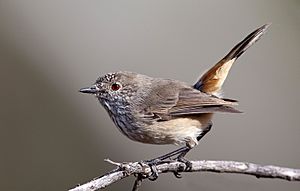Inland thornbill facts for kids
Quick facts for kids Inland thornbill |
|
|---|---|
 |
|
| Conservation status | |
| Scientific classification | |
| Genus: |
Acanthiza
|
| Species: |
apicalis
|
| Subspecies | |
|
|
The inland thornbill (Acanthiza apicalis), also known as the broad-tailed thornbill, is a small bird from Australia. It mainly eats insects. People sometimes confuse it with the brown thornbill because they look quite similar. There are four different types, or subspecies, of the inland thornbill. One of these is called Whitlock's tit, named after F. Lawson Whitlock, who collected some of the first specimens.
Contents
What Does It Look Like?
The inland thornbill is a small bird, usually about 10 centimetres long. It weighs around 7 grams. Its back is grey-brown, and it has a reddish patch near its tail. The tail itself is dark with a white tip. The bird's belly is a creamy color with black streaks. Both male and female thornbills look alike, but males are usually a little bit bigger.
Reproduction and Life Cycle
Inland thornbills have their breeding season from July to December. The female bird usually lays about three eggs at a time. These eggs hatch after about 19 days. Once the baby birds hatch, they stay in the nest for about 17 days before they are ready to fly out on their own.
Where It Lives and What It Eats
You can find the inland thornbill across most of Australia, especially in the areas away from the coast. However, they do not live in the tropical northern parts or in Tasmania. They often live in dry scrublands and woodlands. In southwestern Australia, they also make their homes in sandy areas and forests with karri and jarrah trees.
These birds mostly eat small insects and spiders. Sometimes, they will also eat seeds and small bits of plants. They usually find their food under shrubs or among the leaves of trees.
See also
 In Spanish: Acantiza apical para niños
In Spanish: Acantiza apical para niños


